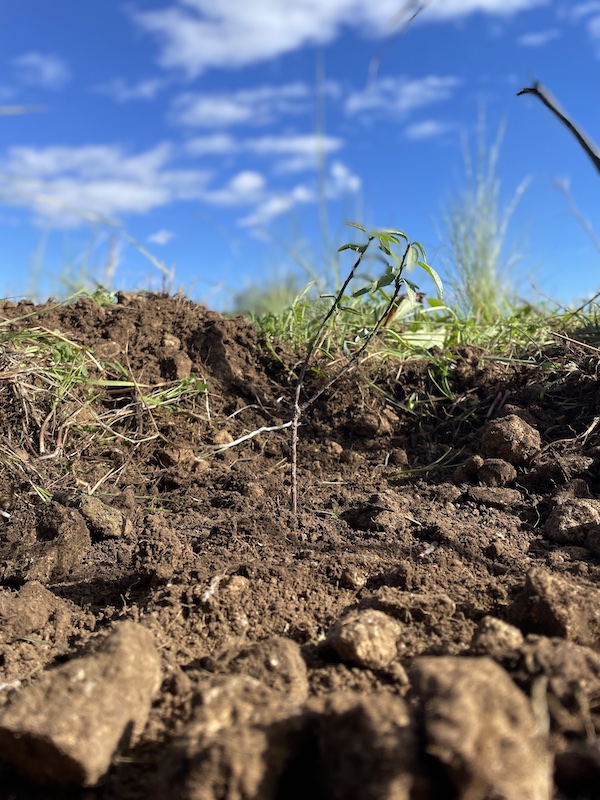The Role of Careful Stewardship in Reforestation Projects
The relationship between trees, soil health, and food production is a vital yet often overlooked aspect of sustainable agriculture.
Trees play a crucial role in maintaining and improving soil health through several mechanisms:
- Soil Erosion Prevention: Tree roots stabilize the soil. This is particularly important in areas prone to heavy rainfall or drought (where we are dealing a lot), where soil loss can severely impact agricultural productivity.
- Nutrient Cycling: Trees contribute organic matter to the soil through leaf litter and root decay. This organic content enhances soil fertility by providing essential nutrients and improving soil structure. Healthy soils can retain more moisture, which is critical for crop growth.
- Microbial Diversity: The presence of trees fosters a diverse range of microorganisms in the soil. These organisms are essential for nutrient cycling and help break down organic matter, making nutrients more available to plants. A rich microbial community also enhances soil resilience against pests and diseases. We saw so clear than different varieties, especially wild and indigenous create a more healthy farm.

While planting more trees is essential, the success of reforestation projects heavily relies on the ongoing care provided by farmers and land stewards:
- Long-Term Commitment: Successful reforestation requires a long-term commitment to nurturing young trees. Farmers must monitor their growth, protect them from pests, and ensure they receive adequate trimming and nutrients during their formative years.
- Adaptive Management: Careful stewardship involves adapting practices based on environmental conditions and tree species needs. Farmers should be trained to recognize signs of stress in trees and adjust their management strategies accordingly.
- Community Engagement: Involving local communities in reforestation efforts fosters a sense of ownership and responsibility. Educating community members about the benefits of trees for both the environment and their livelihoods encourages sustainable practices that extend beyond mere planting.
Trees as a Source of Nutritious Food
Integrating trees into agricultural systems can significantly enhance food security:
- Diverse Food Sources: Trees provide a variety of nutrient-rich foods such as fruits, nuts, and leaves.
- Agroforestry Systems: Combining trees with crops and livestock—known as agroforestry—creates multifunctional landscapes that maximize land use efficiency. These systems not only improve biodiversity but also enhance overall food production by providing multiple sources of income and nutrition.
- Resilience to Climate Change: Trees help mitigate the impacts of climate change by sequestering carbon and regulating local climates. They improve water retention in soils, which can lead to better crop yields even during dry spells. This resilience is crucial for adapting to changing weather patterns that threaten food supplies.

Sustainable Practices for Future Generations
To harness the benefits of trees for soil health and food production, sustainable agricultural practices are our way to live the Farm:
- Promoting Agroforestry: Encouraging farmers to adopt agroforestry practices can lead to improved soil health and increased food diversity. Training programs can help farmers understand the benefits of integrating trees into their farming systems.
- Restoration Initiatives: Efforts to restore degraded lands through tree planting not only improve soil health but also enhance local ecosystems. Initiatives like the Great Green Wall aim to combat desertification while promoting food security across regions.
- Policy Support: Governments should recognize the importance of trees in agricultural policies. Integrating tree planting into food security strategies can enhance both environmental sustainability and nutritional outcomes for communities.
In conclusion, the synergy between trees, soil health, and nutritious food is essential for sustainable agriculture. By prioritizing tree planting and agroforestry practices, we are creating resilient farming systems that support both human nutrition and ecological balance.
Embracing this interconnectedness is key to ensuring a sustainable future for generations to come.
The Role of Careful Stewardship in Reforestation Projects
The relationship between trees, soil health, and food production is a vital yet often overlooked aspect of sustainable agriculture. As the global population continues to grow, ensuring food security while maintaining ecological balance becomes increasingly important. This article explores how trees contribute to soil health and how diligent stewardship by farmers enhances the effectiveness of reforestation efforts in supporting the production of nutritious food.**** The Role of Trees in Enhancing Soil HealthTrees play a crucial role in maintaining and improving soil health through several mechanisms:
- Soil Erosion Prevention: Tree roots stabilize the soil, reducing erosion caused by wind and water. This is particularly important in areas prone to heavy rainfall or drought, where soil loss can severely impact agricultural productivity.
- Nutrient Cycling: Trees contribute organic matter to the soil through leaf litter and root decay. This organic content enhances soil fertility by providing essential nutrients and improving soil structure. Healthy soils can retain more moisture, which is critical for crop growth.
- Microbial Diversity: The presence of trees fosters a diverse range of microorganisms in the soil. These organisms are essential for nutrient cycling and help break down organic matter, making nutrients more available to plants. A rich microbial community also enhances soil resilience against pests and diseases.

